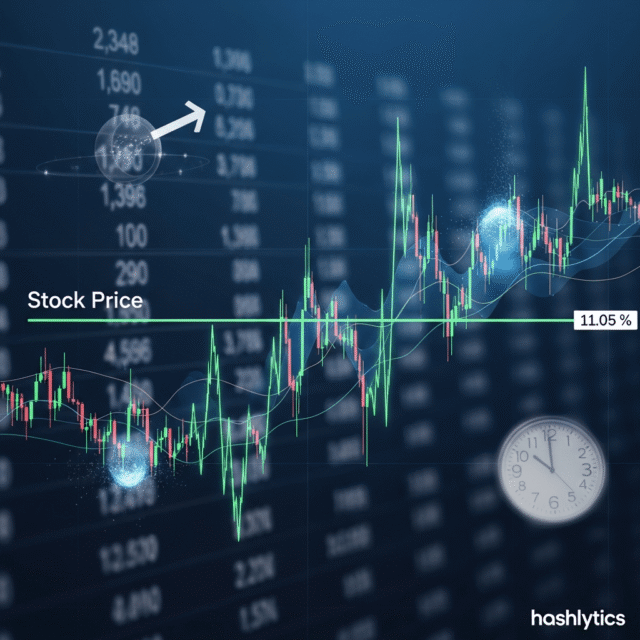The Options Price Mystery
Why does your options price change even when the stock doesn’t move? The answer is not what you think. Behind every option, there are five moving parts called Greeks, and they control how the option behaves regardless of the underlying stock’s immediate price action.
The Five Greeks: Options’ Invisible Forces
Understanding these five variables is essential for anyone trading options, as they explain the seemingly mysterious price movements that occur even when the underlying stock remains static.
Delta: Direction Measurement
Delta measures the directional sensitivity of an option’s price to changes in the underlying stock price.
How Delta Works
If a stock moves by $1, delta tells you how much the option’s price will move with it. For example:
- Delta of 0.50: Option price increases by $0.50 when stock moves up $1
- Delta Range: Call options range from 0 to 1.0; put options range from -1.0 to 0
- At-the-Money Options: Typically have delta around 0.50
- Deep In-the-Money: Delta approaches 1.0 (calls) or -1.0 (puts)
- Far Out-of-the-Money: Delta approaches 0
Practical Implications
Delta also represents the approximate probability that the option will expire in-the-money. A delta of 0.50 suggests roughly a 50% chance of profitability at expiration.
Gamma: Acceleration Measurement
Gamma measures how fast your delta itself is changing. It’s essentially the rate of change of delta, the second derivative of option price with respect to stock price.
Why Gamma Matters
When gamma is high, even small stock moves can make your delta explode. This creates both opportunity and risk:
- High Gamma: Found in at-the-money options near expiration
- Acceleration Effect: Profits (or losses) can compound rapidly
- Delta Instability: Your directional exposure changes dramatically with small price moves
- Time Sensitivity: Gamma increases as expiration approaches
Gamma Risk
High gamma means your position’s directional exposure is unstable. What starts as a mildly bullish position (delta 0.50) can quickly become strongly bullish (delta 0.80) with a small favorable move, or strongly bearish (delta 0.20) with a small adverse move.
Theta: Time Decay Measurement
Theta measures time decay. With each passing day, your option loses time value, even if nothing else happens that day.
The Rent Analogy
It’s like the market’s way of charging rent for holding a position. Time decay is:
- Always Negative for Long Options: You lose value every day you hold
- Accelerating Near Expiration: Decay speeds up in final weeks
- Greatest at-the-Money: At-the-money options lose time value fastest
- Predictable: Unlike other Greeks, theta is relatively constant day-to-day
Theta Strategy
Option sellers benefit from theta decay, while option buyers fight against it. This is why many professional strategies focus on selling options and collecting theta premium.
Vega: Volatility Measurement
Vega measures sensitivity to volatility changes. When uncertainty arises, options get more expensive because fear has a price.
Volatility Premium
That’s why earnings weeks make option premiums spike:
- Implied Volatility Increase: Options become more expensive before uncertain events
- Fear Pricing: Market uncertainty translates to higher option prices
- Post-Event Collapse: After earnings or major announcements, volatility (and option prices) typically crash
- Universal Impact: Affects both calls and puts similarly
Vega Trading
Understanding vega is crucial for event-driven trading. Buying options before earnings can be expensive due to inflated vega, while selling them can be profitable if you believe the volatility premium is excessive.
Rho: Interest Rate Measurement
Rho measures the impact of interest rate changes on option prices. It nudges your option’s value when rates shift.
The Small But Present Force
The difference is small, but it’s never zero:
- Minimal Short-Term Impact: Less significant than other Greeks for most traders
- Long-Dated Options: More sensitive to interest rate changes
- Call vs Put: Calls have positive rho (benefit from rate increases); puts have negative rho
- LEAPS Relevance: More important for long-term options (1+ years to expiration)
When Rho Matters
While often the least impactful Greek for retail traders, rho becomes relevant during periods of rapid interest rate changes or for portfolio managers holding large long-dated option positions.
How the Greeks Work Together
Together, these are the five invisible hands that move your options price. Understanding their interactions explains seemingly paradoxical situations:
Common Scenarios
Scenario 1: Stock Flat, Option Down
- Theta decay erodes time value
- Implied volatility drops (vega impact)
- Result: Option loses value despite unchanged stock price
Scenario 2: Stock Up, Call Option Down
- Delta positive gain from stock increase
- Vega negative loss from volatility crush (larger than delta gain)
- Theta decay compounds the loss
- Result: Winning directional bet still loses money
Scenario 3: Stock Moves Quickly, Option Moves Faster
- High gamma accelerates delta changes
- Increasing delta magnifies gains on continued favorable movement
- Result: Disproportionate profit relative to stock movement
Practical Trading Implications
For Option Buyers
- Fight Theta: Time works against you every day
- Need Movement: Delta gains must exceed theta losses
- Volatility Timing: Buy when implied volatility is low
- Avoid Pre-Event Premium: High vega makes options expensive before earnings
For Option Sellers
- Harvest Theta: Collect time decay systematically
- Manage Delta: Avoid large directional exposure unless intended
- Sell High Volatility: Premium rich when implied volatility elevated
- Watch Gamma: Near expiration, gamma risk can create large delta swings
Why This Matters
Understanding the Greeks transforms options from mysterious instruments to quantifiable tools. You can now explain and anticipate:
- Why your “winning” trade lost money
- How much you’re paying for time and volatility
- When gamma risk becomes dangerous
- Why earnings week options are so expensive
- How professional traders structure positions




